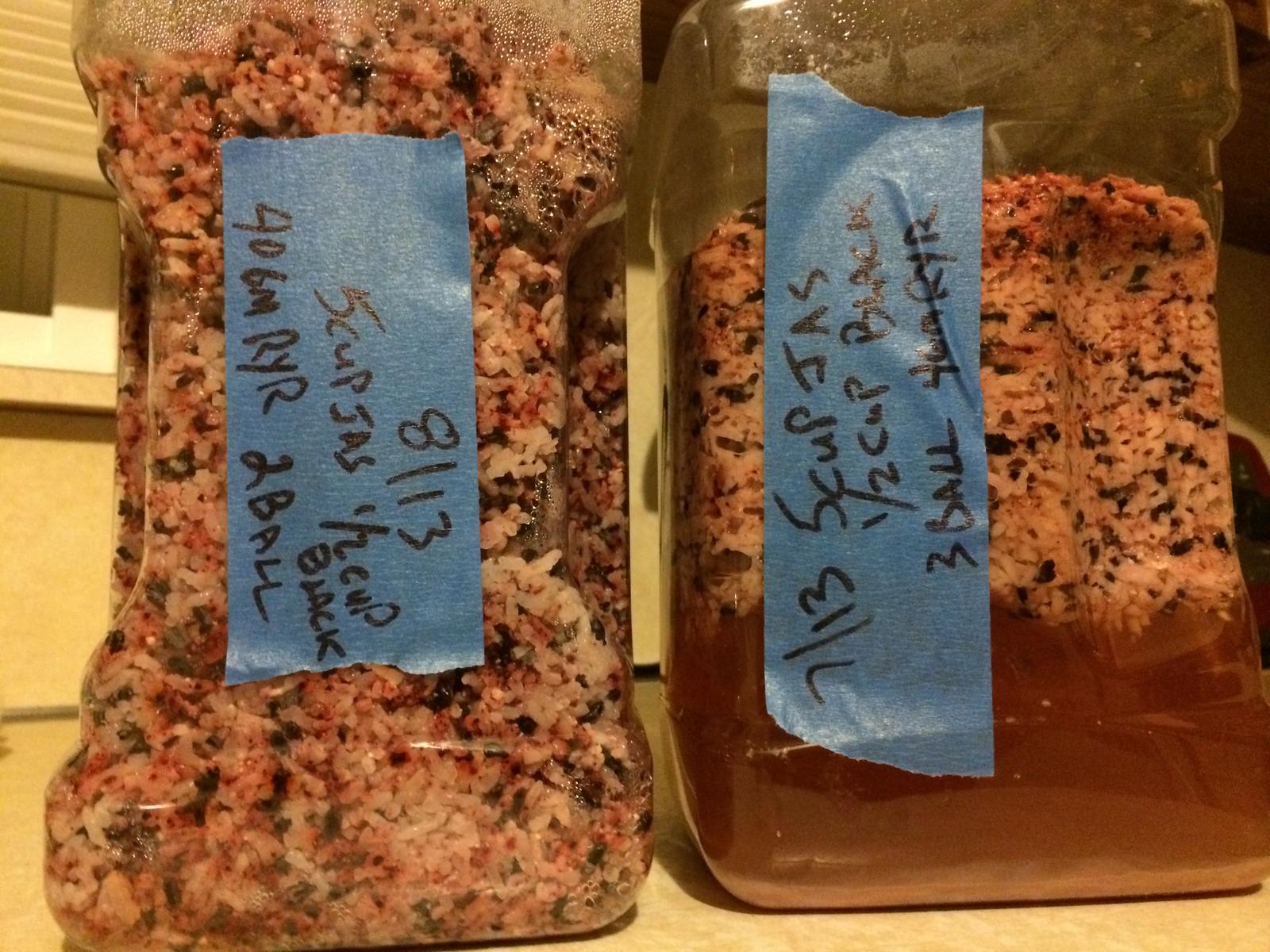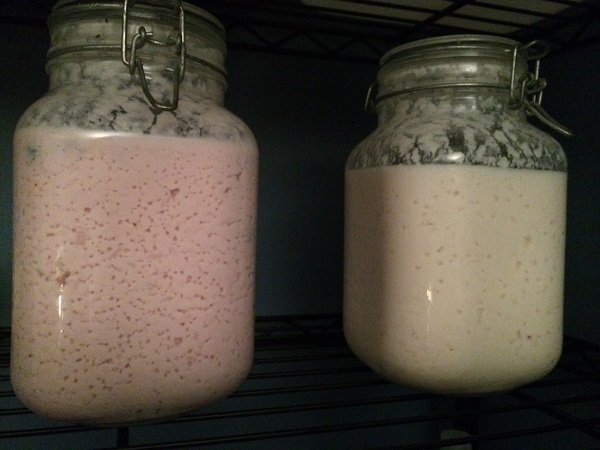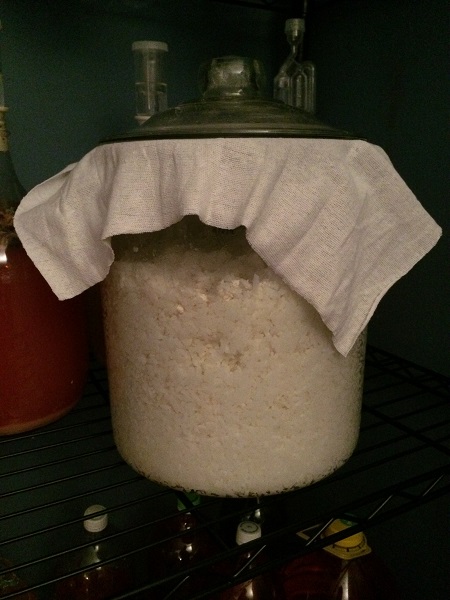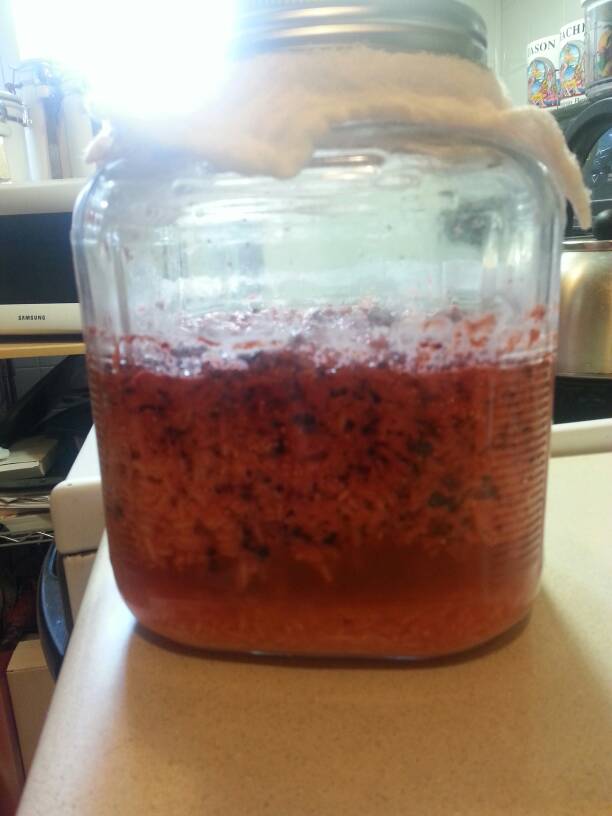Started a fresh batch tonight heavy on the RYR, time to hurry up and wait!
You are using an out of date browser. It may not display this or other websites correctly.
You should upgrade or use an alternative browser.
You should upgrade or use an alternative browser.
Making Traditional rice Wine. Cheap, Fun, and Different
- Thread starter sonofgrok
- Start date

Help Support Homebrew Talk:
This site may earn a commission from merchant affiliate
links, including eBay, Amazon, and others.
Started a fresh batch tonight heavy on the RYR, time to hurry up and wait!
Pics!!!
twofocused
Well-Known Member
Has anyone scaled this up to doing it in a 6.5 gallon brew bucket. I've read enough that I want to try it but, if it's good I wanna have lots of extra to share and partake in.
Thanks, J
Thanks, J
Has anyone scaled this up to doing it in a 6.5 gallon brew bucket. I've read enough that I want to try it but, if it's good I wanna have lots of extra to share and partake in.
Thanks, J
Check out page 328 of this thread. That and a few pages after should help you with a large batch.
MasterCrook
Well-Known Member
- Joined
- Mar 15, 2014
- Messages
- 200
- Reaction score
- 14
Here's the 2 week update on my ARL and RYR batch. Smells and looks amazing. Can't wait to finally have another batch of red! 7 more days feels like a lifetime away.
Coming along nicely!
As requested, One ready for harvest, one started yesterday.



$20.94
$29.99
The Brew Your Own Big Book of Clone Recipes: Featuring 300 Homebrew Recipes from Your Favorite Breweries
Amazon.com

$10.99 ($31.16 / Ounce)
Hornindal Kveik Yeast for Homebrewing - Mead, Cider, Wine, Beer - 10g Packet - Saccharomyces Cerevisiae - Sold by Shadowhive.com
Shadowhive

$58.16
HUIZHUGS Brewing Equipment Keg Ball Lock Faucet 30cm Reinforced Silicone Hose Secondary Fermentation Homebrew Kegging Brewing Equipment
xiangshuizhenzhanglingfengshop

$7.79 ($7.79 / Count)
Craft A Brew - LalBrew Voss™ - Kveik Ale Yeast - For Craft Lagers - Ingredients for Home Brewing - Beer Making Supplies - (1 Pack)
Craft a Brew

$22.00 ($623.23 / Ounce)
AMZLMPKNTW Ball Lock Sample Faucet 30cm Reinforced Silicone Hose Secondary Fermentation Homebrew Kegging joyful
无为中南商贸有限公司

$176.97
1pc Commercial Keg Manifold 2" Tri Clamp,Ball Lock Tapping Head,Pressure Gauge/Adjustable PRV for Kegging,Fermentation Control
hanhanbaihuoxiaoshoudian

$53.24
1pc Hose Barb/MFL 1.5" Tri Clamp to Ball Lock Post Liquid Gas Homebrew Kegging Fermentation Parts Brewer Hardware SUS304(Liquid MFL)
yunchengshiyanhuqucuichendianzishangwuyouxiangongsi

$53.24
1pc Hose Barb/MFL 1.5" Tri Clamp to Ball Lock Post Liquid Gas Homebrew Kegging Fermentation Parts Brewer Hardware SUS304(Liquid Hose Barb)
Guangshui Weilu You Trading Co., Ltd

$49.95 ($0.08 / Fl Oz)
$52.99 ($0.08 / Fl Oz)
Brewer's Best - 1073 - Home Brew Beer Ingredient Kit (5 gallon), (Blueberry Honey Ale) Golden
Amazon.com

$33.99 ($17.00 / Count)
$41.99 ($21.00 / Count)
2 Pack 1 Gallon Large Fermentation Jars with 3 Airlocks and 2 SCREW Lids(100% Airtight Heavy Duty Lid w Silicone) - Wide Mouth Glass Jars w Scale Mark - Pickle Jars for Sauerkraut, Sourdough Starter
Qianfenie Direct
Can some one please explain RYR and ARL? I've tried the search function and looking thru most of the pages of the post. Thanks
I believe:
RYR=red yeast rice
ARL=Angel Rice Leaven
RYR=red yeast rice
ARL=Angel Rice Leaven
Is this the correct mold? First time making it, 8 days old, approx ten cups dry Jasmine rice. There's plenty of liquid so fermentation is going well.
Came out fine. Harvested a litre off of it.
As requested, One ready for harvest, one started yesterday.
I need to start labeling like that.
I need to start labeling like that.I have a batch in the fridge (rice and all) that I need to harvest. It's probably about 8-10 weeks now. LOL!

I've done so many batches, sometimes 4or5 at a time I need to be able to track what's in them somehow.
madwilliamflint
Well-Known Member
- Joined
- Nov 9, 2012
- Messages
- 158
- Reaction score
- 32
So here are my most recent experiments. (Finally got pics of them.) The two jars are jasmine rice, started with the remnants of my first batch (no additional yeast balls or anything.) They're behaving exactly the same, near as I can tell.
One has a handful of blueberries..because why not, rice is cheap.
The cookie jar I put together last night and is 5 pounds of Nishiki and a package of yeast balls (that I'm going to mix in a bit more thoroughly this evening when I get home.)
What's interesting to me is that I never get the kind of liquid differentiation that other pictures seem to indicate here. It never separates on it's own. My 'mixture' just gets soupier and soupier. I generally consider it "done" when it doesn't have enough structure to hold the CO2 in suspension.


One has a handful of blueberries..because why not, rice is cheap.
The cookie jar I put together last night and is 5 pounds of Nishiki and a package of yeast balls (that I'm going to mix in a bit more thoroughly this evening when I get home.)
What's interesting to me is that I never get the kind of liquid differentiation that other pictures seem to indicate here. It never separates on it's own. My 'mixture' just gets soupier and soupier. I generally consider it "done" when it doesn't have enough structure to hold the CO2 in suspension.


Can some one please explain RYR and ARL? I've tried the search function and looking thru most of the pages of the post. Thanks
see below
I believe:
RYR=red yeast rice
ARL=Angel Rice Leaven
That's exactly right. The ARL is another form of the mold/yeast combination that allows rice to break down and ferment.
RYR is an additive to a batch of rice wine that adds a red color and a slightly fruity flavor. In most of my batches, it produces a larger yield and tastes great.
So here are my most recent experiments. (Finally got pics of them.) The two jars are jasmine rice, started with the remnants of my first batch (no additional yeast balls or anything.) They're behaving exactly the same, near as I can tell.
One has a handful of blueberries..because why not, rice is cheap.
The cookie jar I put together last night and is 5 pounds of Nishiki and a package of yeast balls (that I'm going to mix in a bit more thoroughly this evening when I get home.)
What's interesting to me is that I never get the kind of liquid differentiation that other pictures seem to indicate here. It never separates on it's own. My 'mixture' just gets soupier and soupier. I generally consider it "done" when it doesn't have enough structure to hold the CO2 in suspension.
They look fantastic. Do you stir or mix after assembly? I've found that if I just assemble and leave it alone, I get separation. If I mix often, it just gets soupy like in your pics. Have you tried the ARL I sent you? I'm interested to hear your thoughts on any differences you notice.
madwilliamflint
Well-Known Member
- Joined
- Nov 9, 2012
- Messages
- 158
- Reaction score
- 32
They look fantastic. Do you stir or mix after assembly? I've found that if I just assemble and leave it alone, I get separation. If I mix often, it just gets soupy like in your pics. Have you tried the ARL I sent you? I'm interested to hear your thoughts on any differences you notice.
Yeah I shake the crap out of them when they start swelling up. So it's just the "yeah I can't leave well enough alone" then. "nevermind".
I haven't used the ARL yet as I wanted to wait 'til I had more of the same jasmine rice I've been using as a control group. BUT I got a 20 pound bag last night (along with 15 pounds of honey, the woman at the supermarket is convinced I'm insane.)
So I may start a batch with the ARL this weekend, depending on other things I've got going.
I prefer mine clear so I set it and forget it and get the separation and is the reason I was unhappy with my results using the lees to start another batch I ended up with a batch that would not separate.So here are my most recent experiments. (Finally got pics of them.) The two jars are jasmine rice, started with the remnants of my first batch (no additional yeast balls or anything.) They're behaving exactly the same, near as I can tell.
One has a handful of blueberries..because why not, rice is cheap.
The cookie jar I put together last night and is 5 pounds of Nishiki and a package of yeast balls (that I'm going to mix in a bit more thoroughly this evening when I get home.)
What's interesting to me is that I never get the kind of liquid differentiation that other pictures seem to indicate here. It never separates on it's own. My 'mixture' just gets soupier and soupier. I generally consider it "done" when it doesn't have enough structure to hold the CO2 in suspension.
When I get a nice divide I will scoop off alot of the rice off the top and pour off the clear liquid then go back and strain off the rice.
To each his own but you owe it to yourself to try it clear also.

Forgot to mention, rice is cooking for another batch
I prefer mine clear so I set it and forget it and get the separation and is the reason I was unhappy with my results using the lees to start another batch I ended up with a batch that would not separate.
When I get a nice divide I will scoop off alot of the rice off the top and pour off the clear liquid then go back and strain off the rice.
To each his own but you owe it to yourself to try it clear also.
Yeah, I tried a side by side experiment of same Thai jasmine rice and Vietnamese rice wine yeast tablets and mixed one with a chop stick after a few days and left the other one alone. The batch that I mixed up ended up taking much longer to clear than the one I left alone. Minimally greater yield with mixing, but only about 10% more for all of the trouble.
Four days in and showing some nice separation.


Just harvested an experiment I started back around the first of June... it was "Medium Grain" white rice. I mixed it with some ground up RYR and plain RYR as well as a package of ground up yeast balls. Since it was an experiment, I only bought a couple small packages (like 2# total) of the rice. I cooked it up as normal and then put it away and forgot about it for about 2 months. I finally harvested it today. Just enough liquid to overflow a bomber bottle. I poured a little off for head space and tasted it. Very "hot." Not sure how else to describe it.
mythbustingpyro
Well-Known Member
I think I will try this again, in a smaller 1 or 2 gallon jug. Is there any consensus on how much water to cook with and add? Also just a reminder that I am using Korean rice balls, the package is labeled "bo nam cali" if anyone has any experience. May look for some ryr if Im up toward the asian market.
I rinse the rice and boil in approximately 1.25 cups water per cup of rice, 25 mins, leave covered and remove from heat for at least 10 mins before fluffing. Sometimes i'll let it cool overnight.
I never add additional water. No help with the korean balls.
I never add additional water. No help with the korean balls.
I don't rinse, and cook the rice with the amount of water the rice cooker indicates. I don't add any water. I use Chinese yeast balls and Vietnamese yeast 'tablets', so I can't help you with the Korean ones either.
I don't have any experience with the Korean balls either but I can say that I've never added any additional water other than what the rice is cooked in. Sounds like it could be worth doing an experiment since there's water additions when making sake.
mythbustingpyro
Well-Known Member
Alright thanks, I probably should have said tablets instead of balls too. I assume they are from Korea but that is just what the lady at the market said.
madwilliamflint
Well-Known Member
- Joined
- Nov 9, 2012
- Messages
- 158
- Reaction score
- 32
I prefer mine clear so I set it and forget it and get the separation and is the reason I was unhappy with my results using the lees to start another batch I ended up with a batch that would not separate.
When I get a nice divide I will scoop off alot of the rice off the top and pour off the clear liquid then go back and strain off the rice.
To each his own but you owe it to yourself to try it clear also.
a HA! That's important information.
I harvested off my first batch first by straining (put a glop of stuff in the strainer and roll it around until it rolled as a single mass), then pouring into a secondary glass bottle to let separate, then I poured out what was clear and poured the rest back into the primary with everything else.
Those two glass jars I started off the lees from the first batch. And everything seemed fine for weeks (which is why I thought the "starting from lees from a previous batch doesn't work" was hogwash) except for exactly what you just mentioned, it seems to not want to separate.
I went through the same process, but the yield of clear liquid was very small, even though rather a lot came through the strainer on the front end.
What I wonder (based on what I think I know) is if mold spores don't behave like yeast in that they'll just grow ravenously from almost nothing.
So what I did this weekend was crush up and added one yeast ball to each jar to see what happens.
madwilliamflint
Well-Known Member
- Joined
- Nov 9, 2012
- Messages
- 158
- Reaction score
- 32
They look fantastic. Do you stir or mix after assembly? I've found that if I just assemble and leave it alone, I get separation. If I mix often, it just gets soupy like in your pics. Have you tried the ARL I sent you? I'm interested to hear your thoughts on any differences you notice.
Just started an ARL batch this weekend. 6 cups of the same jasmine rice I've been using for the most part.
Just started an ARL batch this weekend. 6 cups of the same jasmine rice I've been using for the most part.
Very good. I'm interested in hearing your thoughts on the difference in taste. Did you use the whole pack?
If you break it down by weight/grams, the package indicates that you'd only need about a 3rd of the pack for the 6 cup batch you made.
I always use the whole pack though since I'd rather over pitch than use not enough.
Similar threads
- Replies
- 0
- Views
- 2K
- Replies
- 45
- Views
- 5K
- Replies
- 89
- Views
- 6K










![Craft A Brew - Safale S-04 Dry Yeast - Fermentis - English Ale Dry Yeast - For English and American Ales and Hard Apple Ciders - Ingredients for Home Brewing - Beer Making Supplies - [1 Pack]](https://m.media-amazon.com/images/I/41fVGNh6JfL._SL500_.jpg)







































